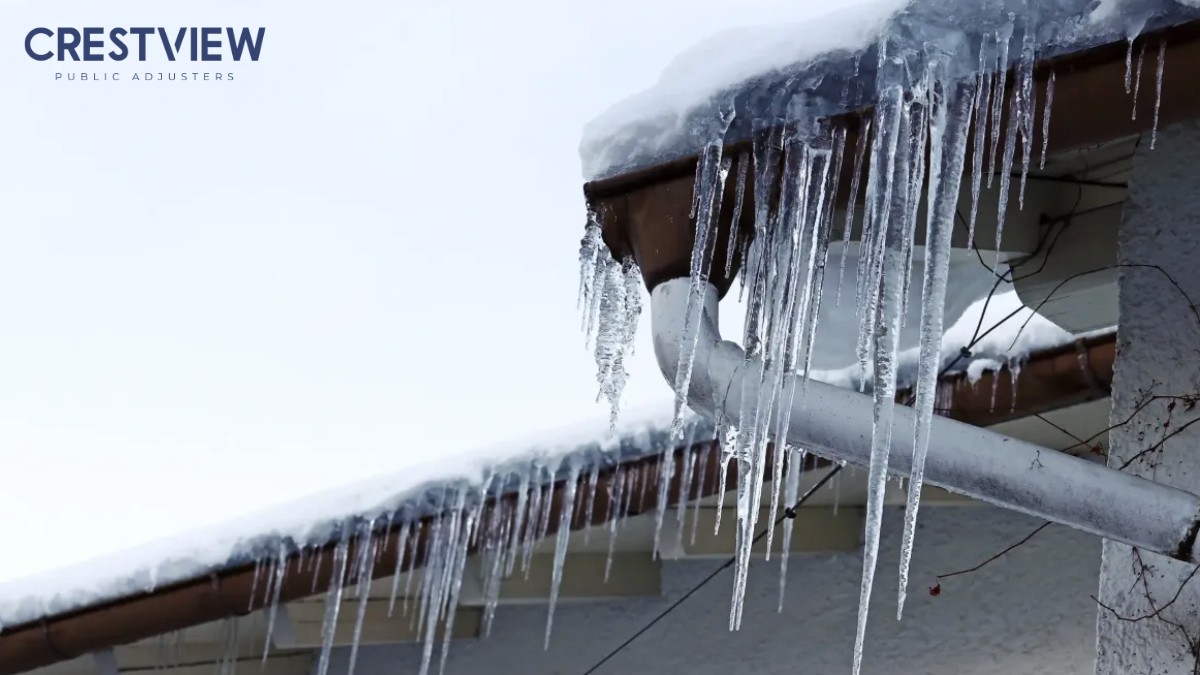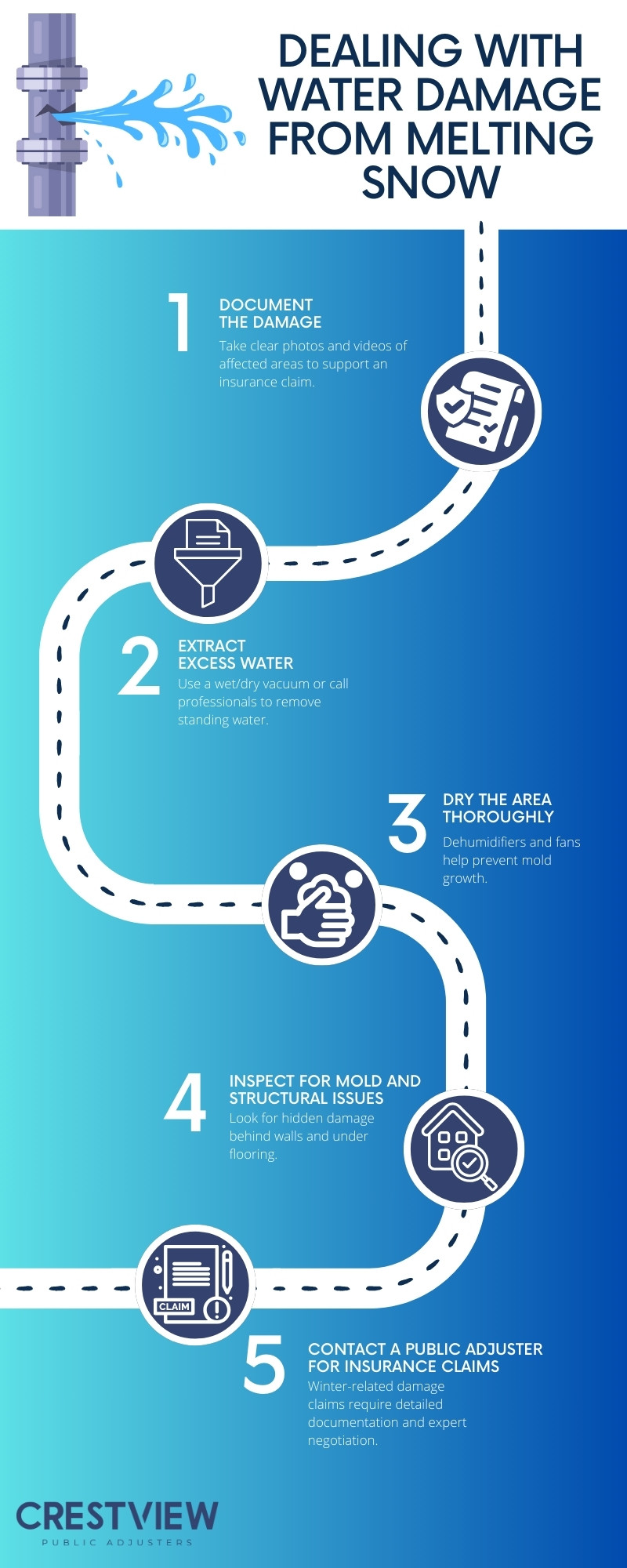Key Points:
- Water damage from melting snow and ice can cause structural issues, mold growth, and property devaluation.
- Key signs include water stains, damp walls, foundation cracks, and warped flooring.
- Insurance claims for winter damage require thorough documentation and expert evaluation.
Melting snow and ice can cause severe water damage to homes, leading to costly repairs and potential structural risks. When snow melts rapidly or ice dams form, water can seep into walls, foundations, and roofing systems. The resulting damage often includes mold growth, weakened infrastructure, and insulation failure, making early assessment crucial.
How Does Melting Snow and Ice Lead to Water Damage?
As temperatures rise, accumulated snow and ice begin to thaw, creating runoff that can infiltrate a building’s structure. Unlike rainfall, meltwater follows unpredictable paths, often pooling in areas not designed for water exposure.
Some common ways melting snow and ice cause damage include:
- Ice Dams: These form when heat escapes from a roof, melting snow at the top while refreezing it near the edges. The trapped water backs up under shingles, leading to leaks.
- Foundation Seepage: As snow melts around a home’s perimeter, water can seep into foundation cracks, causing basement flooding and structural weakening.
- Roof and Gutter Damage: Excessive snow weight or rapid melting can stress roofing materials and gutters, leading to leaks or collapse.
Understanding these risks is the first step in effective water damage assessment.
Signs of Water Damage from Melting Snow and Ice
Early detection of water damage can prevent more extensive repairs. Some of the most telling signs include:
- Water Stains and Discoloration: Yellow or brown stains on ceilings and walls indicate water seepage.
- Peeling Paint or Wallpaper: Excess moisture causes paint and wallpaper to bubble, peel, or warp.
- Warped Flooring: Hardwood and laminate floors may buckle or separate due to prolonged moisture exposure.
- Damp or Musty Odors: Persistent damp smells suggest hidden mold growth.
- Cracks in Walls or Foundations: Expanding ice and water infiltration can lead to structural fractures.
If any of these signs appear after snowmelt, a deeper inspection is necessary to gauge the full extent of the damage.

Areas Most Vulnerable to Snowmelt Water Damage
Certain parts of a home are more susceptible to water damage from melting snow and ice. Key areas to check include:
1. Roof and Attic
A compromised roof allows snowmelt to seep in, leading to leaks, rot, and mold growth. Key indicators of roof damage include:
- Ice dams or icicle formation along eaves.
- Water stains or mold in the attic.
- Loose or missing shingles.
2. Basement and Foundation
Water pooling around a home’s foundation can lead to basement flooding and long-term structural damage. Warning signs include:
- Standing water or damp spots on basement floors.
- Hairline cracks in foundation walls.
- Efflorescence (white, chalky deposits from water seepage).
3. Walls and Insulation
Moisture trapped in walls weakens drywall, insulation, and wooden structures. Look for:
- Soft or sagging drywall.
- Condensation on windows or walls.
- A sudden increase in heating costs due to wet insulation.
Preventing Water Damage from Melting Snow and Ice
While homeowners can’t control the weather, proactive steps can help minimize the risk of water damage. Effective prevention strategies include:
- Clearing Roof Snow Regularly: Use a roof rake to remove excess snow, reducing the likelihood of ice dams.
- Ensuring Proper Drainage: Keep gutters and downspouts clear to direct water away from the home.
- Sealing Foundation Cracks: Apply waterproof sealants to basement walls and foundation cracks.
- Improving Attic Insulation: Proper insulation prevents heat from escaping, reducing snowmelt on the roof.
- Installing a Sump Pump: A sump pump in the basement helps manage water infiltration.
Taking these measures, homeowners can significantly reduce the risk of water damage.
What to Do If Your Home Has Water Damage from Melting Snow and Ice
If your home has suffered winter water damage, quick action is essential to prevent further deterioration. Follow these steps:

Filing an Insurance Claim for Water Damage
Most homeowners’ insurance policies cover sudden and accidental water damage, but coverage varies based on policy terms. Key factors to consider when filing a claim include:
- Policy Inclusions and Exclusions: Some policies exclude gradual damage or flooding.
- Proof of Preventative Measures: Insurers may deny claims if they determine negligence (e.g., clogged gutters).
- Assessment by a Public Adjuster: A public adjuster can evaluate damage, negotiate with insurers, and ensure fair compensation.
Get Expert Help for Winter Water Damage Claims
Water damage from melting snow and ice can be overwhelming, but you don’t have to navigate the claims process alone. Crestview specializes in winter damage claims in New York, New Jersey, and Florida. Our public adjusters advocate for policyholders, ensuring fair settlements for winter-related losses.
Don’t wait—get expert help now. Contact Crestview for a free consultation and maximize your insurance claim.

